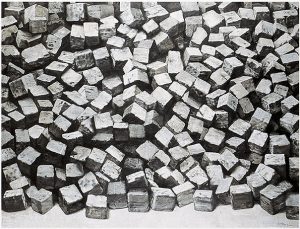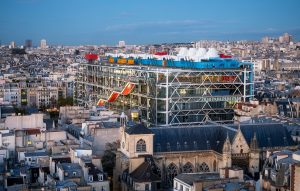Centre Pompidou is home to the most valuable pieces of contemporary art in Europe.Continue reading
László Lakner’s Barricade has been added to the prestigious collection of the Centre Pompidou in Paris. The Barricade, painted in 1972, by one of the most significant artists of the Hungarian neo-avant-garde, was acquired by the Centre Pompidou through the IC Central Europe acquisition committee.
According to a statement from the committee, the painting, a key work of László Lakner’s photorealist period, the first version of which is owned by the Folkwang Museum in Essen, can be interpreted as a monument to the revolution. The painting is a reference to the student riots in Paris in 1968, but also a covert evocation of the 1956 revolution in Budapest.

Barricade (1972). Source: Wikipedia
“The street stone is a politically engaged version of the minimal art cubic motif with a new leftist spirit, which also refers to the topos of socialist realism, the ‘weapon of the proletariat,'” the statement says, adding that
Lakner was among the first artists to rethink and reinterpret this motif, recurring in the conceptual works of several prominent Hungarian artists.
The Barricade is a synthesis of abstract structural sketches and socially sensitive realism.
László Lakner, born in 1936, had exhibitions at the Venice Biennale in 1972, 1976, and 1990, at the Documenta in Kassel in 1977, and at the Biennale of Sydney in 1979. In 1974 he had a solo exhibition at the Neue Galerie – Sammlung Ludwig in Aachen, and then in 1975 at the Neue Berliner Kunstverein. In 1974, he was awarded a DAAD Berliner Künstlerprogramm scholarship, in 1976, the German Critics Prize, and in 1981, a PS1 scholarship to New York. He was awarded the Kossuth Prize in 1998, and has been an Artist of the Nation since 2022. His retrospective exhibition was held at the Ludwig Museum in Budapest from 2004-2005, at the Modem in Debrecen in 2022, and this year at the Muzeum umění Olomouc, in the Czech Republic

Photo via Facebook/Centre Pompidou
Lakner’s most important public collections in Hungary can be found in the Museum of Fine Arts – Hungarian National Gallery, Ludwig Museum – Museum of Contemporary Art, Janus Pannonius Museum, and King St. Stephen Museum. His works can also be seen in numerous public collections abroad, including the Neue Nationalgalerie in Berlin, Hamburger Bahnhof in Berlin, Berlinische Galerie, Folkwang Museum in Essen, Museum Boijmans Van Beuningen in Rotterdam, Museum Ludwig in Cologne, Ludwig Forum für Internationale Kunst in Aachen, Galleria degli Uffizi in Florence, and the Hara Museum in Tokyo.
Via MTI, Featured image: Facebook/MODEM